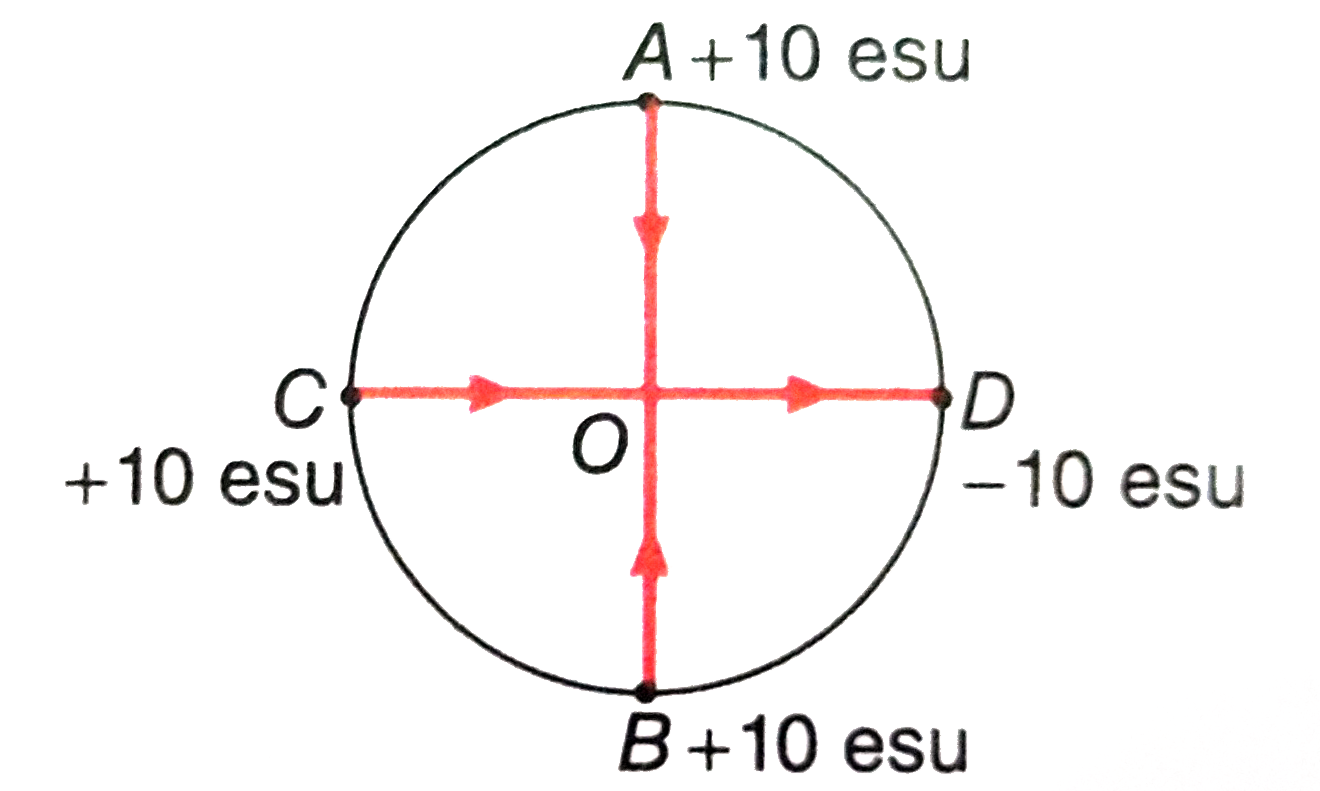AB and CD are two perpendicular diameters of a circle of circumference 20π cm. There are +10 esu, +10 esu, +10 esu and -10 esu of charges at A, B, C and D respectively. What is the Intensity of electric field at the centre O of the circle? What is the direction of the field?Solution in Bengali
Suppose, O is the centre of the circle [Fig. 2.26].

Radius of the circle = r.
Here, 2πr=20π or, r=10 cm
Intensities of electric field at O due to the charges at A and B cancel each other, because the two fields are equal and opposite.Intensity at O due to the charge at C
=10(10)2=110dyn.statC−1, along −−→OD
Intensity at O due to the charge at D
=10(102)=110 dyn.statC−1,along −−→OD
∴ Resultant intensity at O
=(110+110)=0.2 dyn.statC−1, along −−→OD
Topper's Solved these Questions
- BOOK - CHHAYA PUBLICATIONCHAPTER - ELECTRIC FIELDEXERCISE - SECTION RELATION QUESTIONS50videos
ELECTRIC FIELD
- BOOK - CHHAYA PUBLICATIONCHAPTER - ELECTRIC FIELDEXERCISE - HIGHER ORDER THINKING SKILL QUESTIONS33videos
ELECTRIC FIELD
- BOOK - CHHAYA PUBLICATIONCHAPTER - ELECTRIC ENERGY AND POWEREXERCISE - CBSE SCANNER7videos
ELECTRIC ENERGY AND POWER
- BOOK - CHHAYA PUBLICATIONCHAPTER - ELECTRIC POTENTIAL EXERCISE - CBSE Scanner13videos
ELECTRIC POTENTIAL
Similar Questions
State Coulomb's law regarding the force of interaction between two point charge. Define the unit of charge from this law.
04:35View SolutionTwo charges, +qand−q are separated by a distance d. At which points will the resultant electric field intensity be directed parallel to the line joining the charges ?
07:52View SolutionA light bulb is rated 100 W for 220 V ac supply of 50 Hz. Calculate
the resistance of the bulb ,05:05View SolutionA test charge q is moved without acceleration along the path from A to B from B to C in electric field E as shown in fig.

(i) Calculate the potential difference between A and C.03:19View SolutionTwo point charges of +49 esu and +81 esu are placed at a separation of 100 cm in air. Determine the position of the neutral point in the electric fields of the two charges. What is the electric potential at the natural point?
01:30View SolutionFour point charges of +100 esu,-50 esu +20 esu and +30 esu are placed respectively at the four vertices A,B,C,D of a square of side 10 cm. Find the electric intensity and potential at the point of intersection of the diagonals.
View SolutionA negative charge of 30 esu is at a distance of 30 cm from a positive charge of 20 esu. What is the potential at a point 10 cm from the first charge on the line joining the two charges? Where will the potential be zero?
04:30View SolutionThe radii of two insulated metal spheres are 5 cm and 10 cm. They are charged up to potential of 10 esu and 15 esu, respectively. If the two shperes are connected with one another, what will be the loss of energy?
06:19View SolutionTwo charges of +40 esu and −35 esu separated by a distance of 10 cm, exert 4 dyn force on each other. Determine the dielectric constant of the medium.
04:17View SolutionCalculate the fractional charge on each atom of HBr. The dipole moment of HBr is 0.78D and its bond length is 1.41Å. [electronic charge, e=4.8×10−10 esu, 1D=10−10esu⋅cm].
04:35View SolutionA+250 esu of charge P is On the line joining other two charges Q (+50 esu of charge ) and R(−300 esu of charge) in between them. Distance of P from Q is 5 cm and from R it is 10 cm. What the resultant force acting on P?
(##CHY_DMB_PHY_XII_P1_U01_C02_SLV_006_Q01.png" width="80%">02:16View SolutionThree positive charge 3 esu, 4 esu and 5 esu are placed at the vertices of an equilateral triangle of side 10 cm. What is the force acting the largest charge?
View SolutionTwo point charges of 10 esu and 40 esu are located at points A and B seperated by a distance 4 cm. Find the electric field intensity at a point halfway between the charges.
04:09View SolutionTwo point charges +4 esu and +9 esu are placed 10 cm apart. At what point on the line joining them will a unit positive charge experience (i) an equal but opposite and (ii) an equal and unidirectional force?
03:23View SolutionA particle of mass 4 g and charge 10 esu is placed in a uniform electric field of intensity 600V.cm−1. What will be the acceleration of the particle?
01:35View Solution

